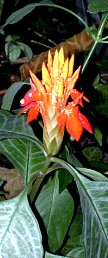 |
We have seen how the soil particles and the space between them interact in determining the drainage of water from a soil and its aeration. What materials can be used to make a good growing medium? |
|
A material called calcined clay, made by heating clay until the tiny clay particles join up in clumps, is more bulky to give support, and has a similar combination of large particle size and internal water holding ability. In theory, it could be used as a growing medium by itself, but it is more often used as only part of a mix. What do we have so far in looking for the growing medium that combines aeration and water-holding? The materials that come originally from plants (peat, coir and bark), and the material that began as rock (calcined clay), all have good qualities, and are a great starting point. Other materials of a rock origin are often added to keep a mix open or give it a longer life. Probably the most common are coarse sand, and two manufactured materials, perlite and vermiculite.
These are the main components of "soilless" mixes, although there are a number of others worth considering. A combination of two or three of these will usually give the required physical characteristics to the mix that ensure the combination of good aeration and some water holding. One part of peat to one of sand or perlite, by volume, is a good start for propagation or for growing. Aged pine bark, peat, and perlite or coarse sand in a 2:1:1 ratio by volume is an easy-to-manage growing medium for most sizes of pots.If you want to experiment with mixing your own, you need to get into the habit of keeping close notes so that you know what works, and what is difficult. The principles here are the same for a single plant or for the largest nursery. What about using topsoil, either by itself or as part of the mix? It is always an option,of course, but one about which it is hard to write without getting into the whole subject of soil science. Put into a pot, topsoil has very different characteristics from those which you may understand well in your garden. It may need to be mixed with something to increase aeration or to hold more water, or simply to make it lighter in weight. Nothing wrong with the soil that has served you in your garden, but treat it as a friendly stranger when you use it for your potted plants until you get to know its strengths and weaknesses for your purpose.
|
|